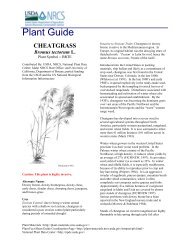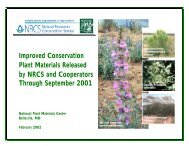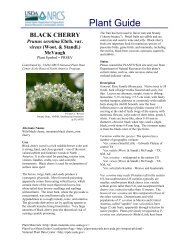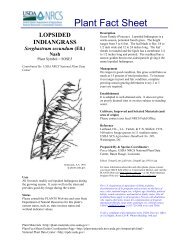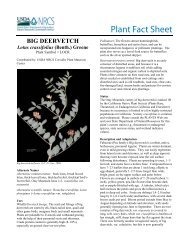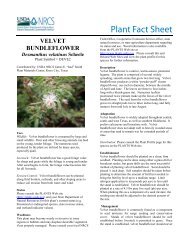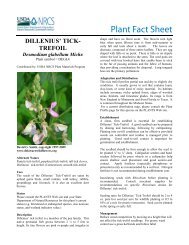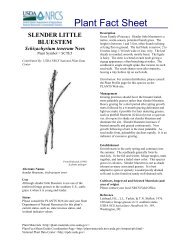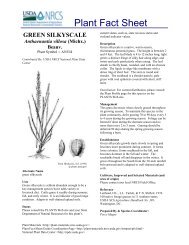Fact Sheet - USDA Plants Database - US Department of Agriculture
Fact Sheet - USDA Plants Database - US Department of Agriculture
Fact Sheet - USDA Plants Database - US Department of Agriculture
You also want an ePaper? Increase the reach of your titles
YUMPU automatically turns print PDFs into web optimized ePapers that Google loves.
GULF CORDGRASS<br />
Spartina spartinae (Trin.)<br />
Merr. ex A.S. Hitchc.<br />
Plant Symbol = SPSP<br />
Contributed by: <strong><strong>US</strong>DA</strong> NRCS Kika de la Garza Plant<br />
Materials Center<br />
<strong><strong>US</strong>DA</strong> NRCS Kika de la Garza Plant Materials Center<br />
Kingsville, TX<br />
Alternate Names<br />
sacahuista, Vilfa spartinae Trin.<br />
Uses<br />
Erosion: Gulf cordgrass (Spartina spartinae) is a<br />
good plant for coastal restoration projects. Its large<br />
dense clumps cause it to catch and hold soil, which is<br />
beneficial in shoreline stabilization.<br />
Wildlife: Gulf cordgrass can provide good bird<br />
nesting habitat and wildlife cover for wetland margin<br />
species. Geese and sandhill cranes are among the<br />
species that make use <strong>of</strong> gulf cordgrass stands.<br />
Mottled ducks are also known to nest in dense<br />
clumps.<br />
Forage: Gulf cordgrass can also be a good source <strong>of</strong><br />
cattle and geese forage when managed properly.<br />
Domestic livestock do not eat unburned gulf<br />
cordgrass, but will graze it heavily following a<br />
Plant <strong>Fact</strong> <strong>Sheet</strong><br />
prescribed burn. The new, young shoots are tender,<br />
but older mature plants are too tough even for horses.<br />
Status<br />
Please consult the PLANTS Web site and your State<br />
<strong>Department</strong> <strong>of</strong> Natural Resources for this plant’s<br />
current status (e.g. threatened or endangered species,<br />
state noxious status, and wetland indicator values).<br />
Description<br />
Gulf cordgrass is a stout, native, perennial grass that<br />
grows in dense clumps. It has a non-rhizomatous<br />
base, although occasionally it can be sub-rhizomatous<br />
towards the outer edges <strong>of</strong> the clump. Also called<br />
sacahuista, the tips <strong>of</strong> this grass’s leaf blades are<br />
sharp and spine-like. It flowers in spring, summer,<br />
and rarely in the fall. It is moderately saline tolerant<br />
(0-18 ppt.), and does well in mesic areas. It can even<br />
grow in soils that are occasionally submerged, but are<br />
above sea level most <strong>of</strong> the time.<br />
The genus name comes from the Greek word<br />
“spartine’, meaning cord from spartes or Spartium<br />
junceum. The genus name probably was given<br />
because the leaf blades are tough, like cords; hence,<br />
the common name cordgrass.<br />
Adaptation and Distribution<br />
Gulf cordgrass grows along the Gulf Coast from<br />
Florida to Texas, and South into Eastern Mexico.<br />
More rarely, gulf cordgrass grows inland in marshes,<br />
swamps, and moist prairies. It can also be found<br />
along the Caribbean coasts, and inland in Argentina<br />
and Paraguay.<br />
In Texas, it can be found along the gulf coast on<br />
coastal flats and around brackish marshes. It is<br />
occasionally found in inland marshes and salt flats in<br />
the Post Oak Savannah, Rio Grande Plains, and<br />
Edwards Plateau Regions. Gulf cordgrass grows<br />
mostly on clayey soils, but at the Plant Material<br />
Center, we have had success growing it on sandier<br />
soils as well. Physical and chemical soil properties<br />
do not seem to influence the occurrence <strong>of</strong> gulf<br />
cordgrass, but elevation in relation to inundation is a<br />
key factor.<br />
For a current distribution map, please consult the<br />
Plant Pr<strong>of</strong>ile page for this species on the PLANTS<br />
Web site.<br />
Plant Materials <br />
Plant <strong>Fact</strong> <strong>Sheet</strong>/Guide Coordination Page <br />
National Plant Data Center
Establishment<br />
Gulf cordgrass is best reproduced vegetatively for<br />
coastal shoreline projects by dividing large clumps<br />
into several smaller ones. The success rate at the<br />
Plant Materials Center has been 75-80%. Use <strong>of</strong> a<br />
rooting hormone is recommended, but is not a<br />
necessity. We recommend placing containers (we<br />
use trays <strong>of</strong> 1”x 1”x 6” or 2”x 2”x 6” paper bands or<br />
cone-tainers) with new cuttings in a trough with<br />
water about 1” up from the bottom <strong>of</strong> the containers,<br />
so that soil stays wet from the bottom up.<br />
After about four to six weeks, remove the containers<br />
from the water bath and begin to harden plants <strong>of</strong>f<br />
prior to planting. The potted cuttings can be<br />
transplanted six to eight weeks after they are started.<br />
<strong>Plants</strong> can be maintained in the greenhouse longer if<br />
necessary, and older plants can be resplit to start new<br />
ones. Larger vegetative clumps can be transplanted<br />
to new sites successfully.<br />
Restoration <strong>of</strong> coastal sites by seeding may also be<br />
successful. Currently the Kika de la Garza PMC is<br />
evaluating the seed potential <strong>of</strong> gulf cordgrass. Two<br />
accessions have had over 30% seed germination over<br />
two successive years. Seed yeild has averaged 330<br />
pounds per acre, with approximately 454,000 seeds<br />
per pound.<br />
In 1997-98, Kika de la Garza Plant Materials Center<br />
staff used gulf cordgrass transplants in a coastal<br />
shoreline stabilization project that they worked on in<br />
partnership with the San Patricio (Texas) Soil and<br />
Water Conservation District. Gulf cordgrass had a<br />
97% survival rate, and was found to be best adapted<br />
to planting sites 2 feet above the mean tide level.<br />
Management<br />
Gulf cordgrass should be burned periodically to<br />
increase forage palatability and wildlife utilization.<br />
Once burned, it should be grazed continuously to<br />
maintain tender regrowth.<br />
Gulf cordgrass requires little management otherwise.<br />
It appears to be fairly drought tolerant and does not<br />
require irrigation except when establishing new<br />
transplants. Any weeds can easily be removed when<br />
processing plants.<br />
Prepared By & Species Coordinator:<br />
John Lloyd-Reilley, Manager<br />
Elizabeth Kadin, Research Assistant<br />
Shelly D. Maher, Research Scientist<br />
Kika de la Garza Plant Materials Center<br />
Kingsville, Texas<br />
1Oct2003 SDM; Edited 05Nov2003 jlk; 24may06jsp<br />
For more information about this and other plants, please contact<br />
your local NRCS field <strong>of</strong>fice or Conservation District, and visit the<br />
PLANTS Web site or the Plant Materials<br />
Program Web site <br />
The U.S. <strong>Department</strong> <strong>of</strong> <strong>Agriculture</strong> (<strong><strong>US</strong>DA</strong>) prohibits<br />
discrimination in all its programs and activities on the basis <strong>of</strong><br />
race, color, national origin, sex, religion, age, disability, political<br />
beliefs, sexual orientation, and marital or family status. (Not all<br />
prohibited bases apply to all programs.) Persons with disabilities<br />
who require alternative means for communication <strong>of</strong> program<br />
information (Braille, large print, audiotape, etc.) should contact<br />
<strong><strong>US</strong>DA</strong>'s TARGET Center at 202-720-2600 (voice and TDD).<br />
To file a complaint <strong>of</strong> discrimination write <strong><strong>US</strong>DA</strong>, Director, Office<br />
<strong>of</strong> Civil Rights, Room 326-W, Whitten Building, 14th and<br />
Independence Avenue, SW, Washington, DC 20250-9410 or call<br />
202-720-5964 (voice or TDD). <strong><strong>US</strong>DA</strong> is an equal opportunity<br />
provider and employer.<br />
Read about Civil Rights at the Natural Resources Convervation<br />
Service.



